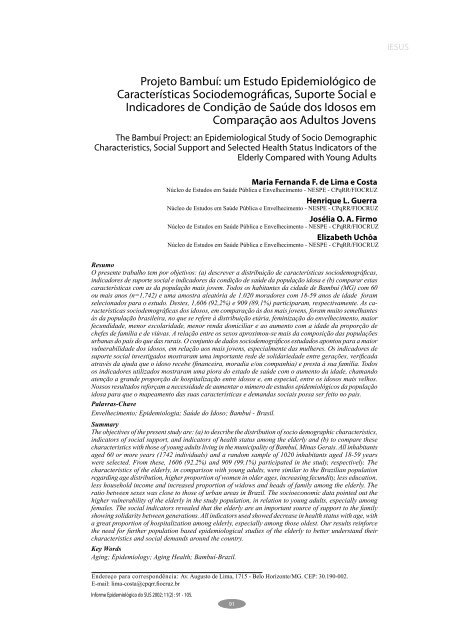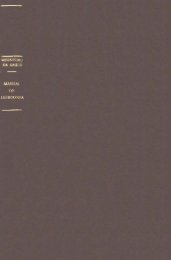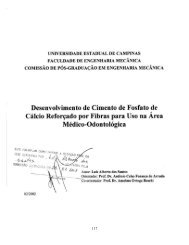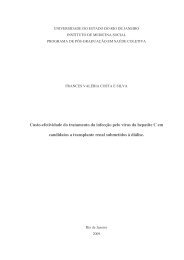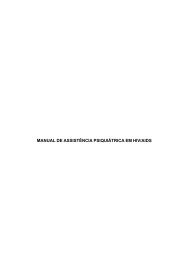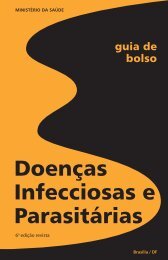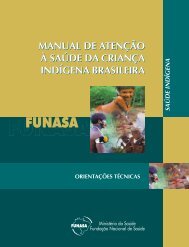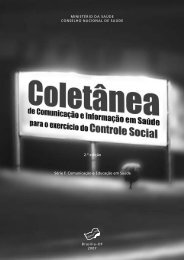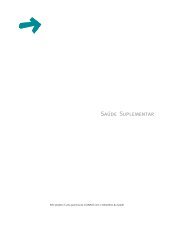informe epidemiológico do sus informe epidemiológico do sus
informe epidemiológico do sus informe epidemiológico do sus
informe epidemiológico do sus informe epidemiológico do sus
You also want an ePaper? Increase the reach of your titles
YUMPU automatically turns print PDFs into web optimized ePapers that Google loves.
Projeto Bambuí: um Estu<strong>do</strong> Epidemiológico de<br />
Características Sociodemográficas, Suporte Social e<br />
Indica<strong>do</strong>res de Condição de Saúde <strong>do</strong>s I<strong>do</strong>sos em<br />
Comparação aos Adultos Jovens<br />
The Bambuí Project: an Epidemiological Study of Socio Demographic<br />
Characteristics, Social Support and Selected Health Status Indicators of the<br />
Elderly Compared with Young Adults<br />
Resumo<br />
O presente trabalho tem por objetivos: (a) descrever a distribuição de características sociodemográficas,<br />
indica<strong>do</strong>res de suporte social e indica<strong>do</strong>res da condição de saúde da população i<strong>do</strong>sa e (b) comparar estas<br />
características com as da população mais jovem. To<strong>do</strong>s os habitantes da cidade de Bambuí (MG) com 60<br />
ou mais anos (n=1,742) e uma amostra aleatória de 1.020 mora<strong>do</strong>res com 18-59 anos de idade foram<br />
seleciona<strong>do</strong>s para o estu<strong>do</strong>. Destes, 1,606 (92,2%) e 909 (89,1%) participaram, respectivamente. As características<br />
sociodemográficas <strong>do</strong>s i<strong>do</strong>sos, em comparação às <strong>do</strong>s mais jovens, foram muito semelhantes<br />
às da população brasileira, no que se refere à distribuição etária, feminização <strong>do</strong> envelhecimento, maior<br />
fecundidade, menor escolaridade, menor renda <strong>do</strong>miciliar e ao aumento com a idade da proporção de<br />
chefes de família e de viúvas. A relação entre os sexos aproximou-se mais da composição das populações<br />
urbanas <strong>do</strong> país <strong>do</strong> que das rurais. O conjunto de da<strong>do</strong>s sociodemográficos estuda<strong>do</strong>s apontou para a maior<br />
vulnerabilidade <strong>do</strong>s i<strong>do</strong>sos, em relação aos mais jovens, especialmente das mulheres. Os indica<strong>do</strong>res de<br />
suporte social investiga<strong>do</strong>s mostraram uma importante rede de solidariedade entre gerações, verificada<br />
através da ajuda que o i<strong>do</strong>so recebe (financeira, moradia e/ou companhia) e presta à sua família. To<strong>do</strong>s<br />
os indica<strong>do</strong>res utiliza<strong>do</strong>s mostraram uma piora <strong>do</strong> esta<strong>do</strong> de saúde com o aumento da idade, chaman<strong>do</strong><br />
atenção a grande proporção de hospitalização entre i<strong>do</strong>sos e, em especial, entre os i<strong>do</strong>sos mais velhos.<br />
Nossos resulta<strong>do</strong>s reforçam a necessidade de aumentar o número de estu<strong>do</strong>s <strong>epidemiológico</strong>s da população<br />
i<strong>do</strong>sa para que o mapeamento das suas características e demandas sociais possa ser feito no país.<br />
Palavras-Chave<br />
Envelhecimento; Epidemiologia; Saúde <strong>do</strong> I<strong>do</strong>so; Bambuí - Brasil.<br />
Summary<br />
The objectives of the present study are: (a) to describe the distribution of socio demographic characteristics,<br />
indicators of social support, and indicators of health status among the elderly and (b) to compare these<br />
characteristics with those of young adults living in the municipality of Bambuí, Minas Gerais. All inhabitants<br />
aged 60 or more years (1742 individuals) and a ran<strong>do</strong>m sample of 1020 inhabitants aged 18-59 years<br />
were selected. From these, 1606 (92.2%) and 909 (99.1%) participated in the study, respectively. The<br />
characteristics of the elderly, in comparison with young adults, were similar to the Brazilian population<br />
regarding age distribution, higher proportion of women in older ages, increasing fecundity, less education,<br />
less household income and increased proportion of wi<strong>do</strong>ws and heads of family among the elderly. The<br />
ratio between sexes was close to those of urban areas in Brazil. The socioeconomic data pointed out the<br />
higher vulnerability of the elderly in the study population, in relation to young adults, especially among<br />
females. The social indicators revealed that the elderly are an important source of support to the family<br />
showing solidarity between generations. All indicators used showed decrease in health status with age, with<br />
a great proportion of hospitalization among elderly, especially among those oldest. Our results reinforce<br />
the need for further population based epidemiological studies of the elderly to better understand their<br />
characteristics and social demands around the country.<br />
Key Words<br />
Aging; Epidemiology; Aging Health; Bambuí-Brazil.<br />
Informe Epidemiológico <strong>do</strong> SUS 2002; 11(2) : 91 - 105.<br />
Maria Fernanda F. de Lima e Costa<br />
Núcleo de Estu<strong>do</strong>s em Saúde Pública e Envelhecimento - NESPE - CPqRR/FIOCRUZ<br />
Henrique L. Guerra<br />
Núcleo de Estu<strong>do</strong>s em Saúde Pública e Envelhecimento - NESPE - CPqRR/FIOCRUZ<br />
Josélia O. A. Firmo<br />
Núcleo de Estu<strong>do</strong>s em Saúde Pública e Envelhecimento - NESPE - CPqRR/FIOCRUZ<br />
Elizabeth Uchôa<br />
Núcleo de Estu<strong>do</strong>s em Saúde Pública e Envelhecimento - NESPE - CPqRR/FIOCRUZ<br />
Endereço para correspondência: Av. Augusto de Lima, 1715 - Belo Horizonte/MG. CEP: 30.190-002.<br />
E-mail: lima-costa@cpqrr.fiocruz.br<br />
91<br />
IESUS


